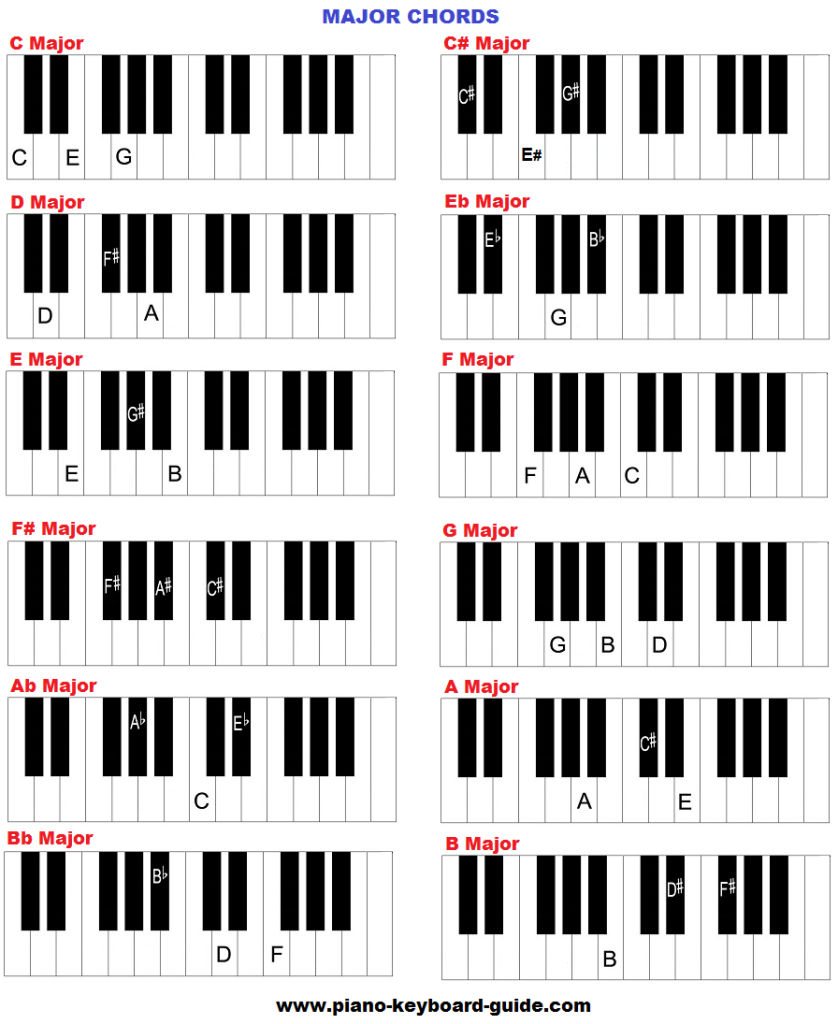Major chords are usually the first type of chords one learns. Along with minor chords they are the most basic and easiest ones. They create a happy mood, unlike minor chords which are generally sad in nature.
They consist of three notes, a root, a major third and a perfect fifth (1 – 3 – 5). For instance, in the chord C major consists of the notes, C (the root), E (the major third), and G (the perfect fifth). To add another example, the chord F major consists of the notes F, A and C. The maj chord gets its name from the root note.
I wrote this amazing book that will help you with your chords. Click here to get your copy at a discounted price.
The root is the note upon which the chord is based. For example, the root of G major is G, no matter what the inversion.
The major third is the third note in a major scale. Using the same note G, as an example, the major third is B. B is four half steps above the root note.
The perfect fifth is the fifth note in the major (or minor) scale. It is seven half steps above the root note. Using the note G again, the perfect fifth is D. D is three half steps above the major third.
Clearly, you can form this type of chord by using half steps. The formula is R + 4HS + 3 HS (root plus 4 half steps + 3 half steps).
Take a look at your piano keyboard. Play any key. To form a major chord corresponding to that key or note simply hold that note, then skip two keys and play the key to the right, then skip two keys and play the key to the right.
Watch This Lesson: (How To Form Major Scales First, Then Chords)
Key Patterns for all 12 major triads
Perhaps the easiest major chords to play on piano are the chords, C, F and G. This is due to the fact that the consist of white notes only. We’ve already looked at C and F. The notes for G major are G, B and D.
There are three chords which follow the pattern, white key, black key, white key. These are the chords, D, E and A major.
Three major triads are made up of the pattern black key, white key, black key. They are Db, Eb and Ab.
Lastly, there are three chords with an odd pattern. Gb major consists of all black keys, Bb major is made up of the pattern, black key, white key, white key, and B major, white key, black key, black key.
Practice the all white key chords first, then move to the other patterns we highlighted above in the other presented.
To learn more about this chord and others, check out my course, Piano Chords: How To Form Basic Chords On Piano And Keyboard.

Major chords in all 12 keys (Chords and notes that make up that chord starting with the root, followed by major third, then perfect fifth)
- C major: C – E – G
- C sharp major: C# – E# (F) – G#
- D flat major: Db – F – Ab
- D major: D – F# – A
- D sharp major: D# – G – A#
- E flat major: Eb – G – Bb
- E major: E – G# – B
- F major: F – A – C
- F sharp major: F# – A# – C#
- G flat major: Gb – Bb – Db
- G major – G – B – D
- G sharp major: G# – B# (C) – D#
- A flat major: Ab – C – Eb
- A major: A – C# – E
- A# major: A# – C## (D) – E# (F)
- B flat major: Bb – D – F
- B major: B – D# – F#
Some of the chords have different names but on piano you play the same keys. These are known as enharmonics. For instance, Eb is the enharmonic equivalent of D#, Ab is the enharmonic equivalent of G#, Bb is the enharmonic equivalent of A#, and so on.
Triad Root Position and Inversions
When playing major chords, the root note is not always the lowest note you hold. Same applies for any of the three notes in the chord. What we have presented so far are the chords in root position. In root position, the lowest note of the chord is the root note.
Triads also have what is known as a first inversion. The root note is moved to the top, an octave higher. So in the case of C major, for instance, instead of playing C – E – G (1+3+5), you now play E – G – C (3+5+1).
For the second inversion, the the lowest note of the first inversion is moved to the top. So E – G – C (3+5+1) becomes G – C – E (5+1+3).
More information on major chords and other chords